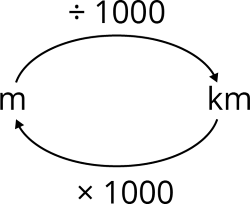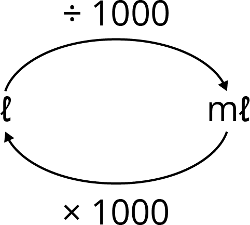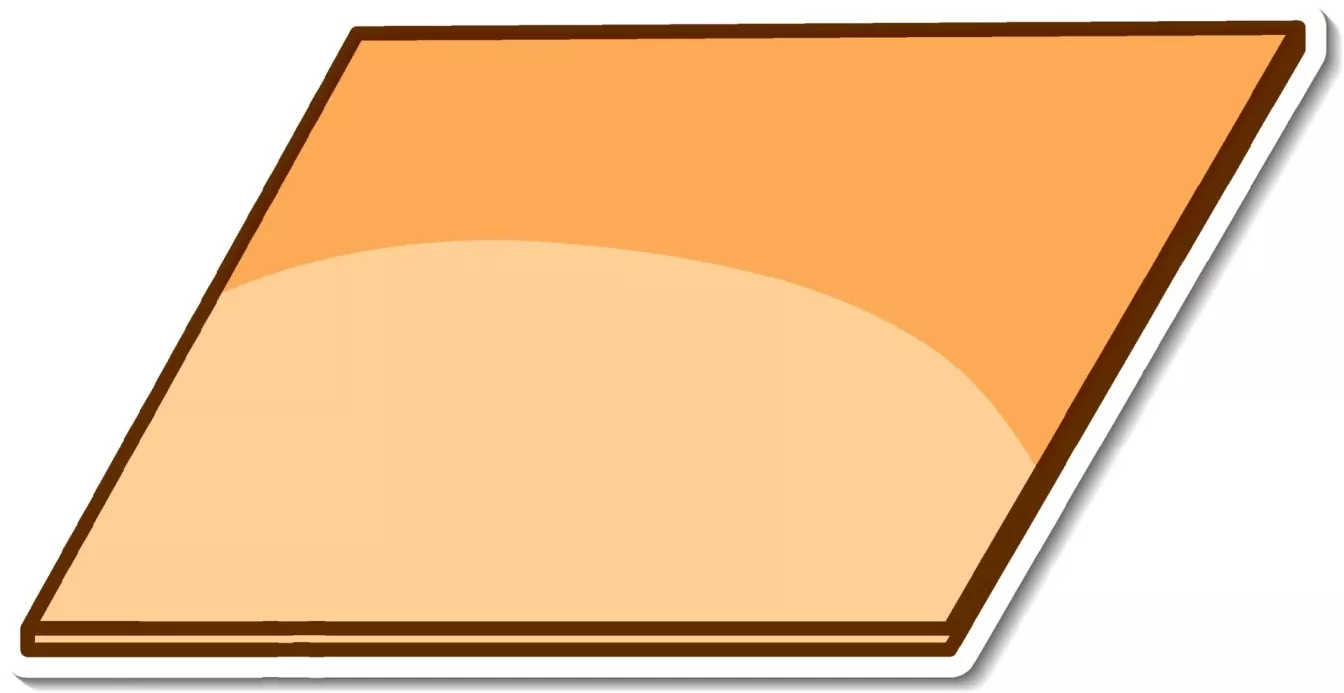Decimals - Operations & Conversions
In this article we will learn about Decimals. We will study the various operations and the conversions of decimals into fractions and vice versa. The details covered are as per the Primary 5 Math requirements.
The lesson objectives are:
- Multiplying by \(10\), \(100\) or \(1000\)
- Multiplying by multiples of \(10\), \(100\) or \(1000\)
- Dividing by \(10\), \(100\) or \(1000\)
- Dividing by multiples of \(10\), \(100\) or \(1000\)
- Conversion of measurements
Conversion of fractions to decimals and vice-versa
Question 1:
Express \(\begin{align} 1\frac {3}{5} \end{align}\) as decimal.
Solution:
\(\begin {align*} 1\frac {3}{5} &= 1\frac {6}{10} \\[2ex] &= 1.6 \end {align*}\)
Answer:
\(1.6\)
Question 2:
Express \(\begin{align} 2\frac {1}{4} \end{align}\) as decimal.
Solution:
\(\begin {align*} 2\frac {1} {4} &= 2\frac {25}{100} \\[2ex] &= 2.25 \end {align*}\)
Answer:
\(2.25\)
Question 3:
Express \(\begin{align} 3\frac {3}{8} \end{align}\) as a decimal.
Solution:
\(\begin {align*} 3 \frac {3} {8} &= 3 \frac {375}{1000} \\[2ex] &= 3.375 \end {align*}\)
Answer:
\(3.375\)
Question 4:
Express \(\begin{align} 2\frac {5}{9} \end{align}\) as a decimal rounded to \(2\) decimal places.
Solution:

\(\begin {aligned} \frac {5} {9} &≈ 0.555 \\[2ex] &≈ 0.56 \quad \text{(2 decimal places)} \\[4ex] 2 \frac {5} {9} &= 2+ \frac {5} {9} \\[2ex] &≈ 2+0.56\\[2ex] &≈ 2.56 \quad \text{(2 decimal places)} \end {aligned}\)
Answer:
\(2.56\)
Question 5:
Express \(1.4\) as a fraction in its simplest form.
Solution:
\(\begin {align*} 1.4 &= 1 \frac {4}{10} \\[2ex] &= 1 \frac {2}{5} \end {align*}\)
Answer:
\(\begin{align} 1 \frac {2}{5} \end{align}\)
Question 6:
Express \(2.12\) as a fraction in its simplest form.
Solution:
\(\begin {align*} 2.12 &= 2 \frac {12}{100} \\[2ex] &= 2 \frac {3}{25} \end {align*}\)
Answer:
\(\begin{align} 2 \frac {3}{25} \end{align}\)
Question 7:
Express \(3.625\) as a fraction in its simplest form.
Solution:
\(\begin {align*} 3.625 &= 3 \frac {625}{1000} \\[2ex] &= 3 \frac {5}{8} \end {align*}\)
Answer:
\(\begin{align} 3 \frac {5}{8} \end{align}\)
1. Multiplying by \(10\), \(100\) or \(1000\)
Tip: When a decimal is multiplied by \(10\), \(100\) or \(1000\), the decimal point shifts to the right by the number of ‘\(0\)’s.
Example:

Question 1:
Multiply \(5.9\) by \(10\).
Solution:
\(5\overset{\:\curvearrowright}{.9} \times 10 = 59\)
Answer:
\(59\)
Question 2:
Multiply \(0.404\) by \(100\).
Solution:
\(4 \overset{\:\:\curvearrowright}{.4}\overset{\:\curvearrowright}{0}\:4 \times 100 = 440.4\)
Answer:
\(40.4\)
Question 3:
Multiply \(76.9\) by \(1000\).
Solution:
\(76 \overset{\:\curvearrowright}{.9}\overset{\:\curvearrowright}{\phantom{9}}\overset{\:\curvearrowright}{\phantom{9}} \times 1000 = 76\,900\)
Answer:
\(76 \;900\)
2. Multiplying by multiples of \(10\), \(100\) or \(1000\)
Examples:

Question 1:
Multiply \(0.05\) by \(60. \)
Solution:
\(\begin{aligned} 0.05 \times 60 &= 0 \overset{\:\curvearrowright}{.0}\,5 \times 10 \times 6\\[2ex] &= 0.5 \times 6\\[2ex] &= 3 \end{aligned}\)
Answer:
\(3\)
Question 2:
Multiply \(3.64\) by \(300.\)
Solution:
\(\begin{aligned} 3.64 \times 300 &= 3 \overset{\:\curvearrowright}{.6}\overset{\curvearrowright}{4} \times 100 \times 3\\[2ex] &= 364 \times 3\\[2ex] &= 1092 \end{aligned}\)
Answer:
\(1092\)
Question 3:
Multiply \(2.617\) by \(7000\).
Solution:
\(\begin{aligned} 2.617 \times 7000 &= 2 \overset{\:\curvearrowright}{.6}\overset{\:\curvearrowright}{1}\overset{\:\curvearrowright}{7} \times 1000 \times 7\\[2ex] &= 2617 \times 7\\[2ex] &= 18\;319 \end{aligned}\)
Answer:
\(18 \;319\)
3. Dividing by \(10\), \(100\) or \(1000\)
Tip: When a decimal is divided by \(10\), \(100\) or \(1000\) the decimal point shifts to the left by the number of ‘\(0\)’s.
Examples:

Question 1:
Divide \(5.8\) by \(10\).
Solution:
\(\overset{\curvearrowleft}{\;\;5.}\:8 \div 10 = 0.58 \)
Answer:
\(0.58\)
Question 2:
Divide \(30.3\) by \(100\).
Solution:
\(\overset{\curvearrowleft}{\;3}\overset{\curvearrowleft}{\;\:0.}\;3 \div 100 = 0.303\)
Answer:
\(0.303\)
Question 3:
Divide \(2\) by \(1000\).
Solution:
\( \overset{\curvearrowleft}{\phantom{2}} \overset{\curvearrowleft}{\phantom{2}}\overset{\curvearrowleft}{\;2} \div 1000 = 0.002\)
Answer:
\(0.002\)
4. Dividing by multiples of \(10\), \(100\) or \(1000\)
Examples:

Question 1:
Divide \(2.1\) by \(30\).
Solution:
\(\begin{aligned} 2.1 \div 30 &= \overset{\curvearrowleft}{\:2.}1 \div 10 \div 3\\[2ex] &= 0.21 \div 3\\[2ex] &= 0.07 \end{aligned}\)
Answer:
\(0.07\)
Question 2:
Divide \(763\) by \(700\).
Solution:
\(\begin{aligned} 763 \div 700 &= 7 \overset{\:\curvearrowleft}{\:6}\overset{\:\curvearrowleft}{\:3} \div 100 \div 7\\[2ex] &= 7.63 \div 7\\[2ex] &= 1.09 \end{aligned}\)
Answer:
\(1.09\)
Question 3:
Divide \(535\) by \(5000\).
Solution:
\(\begin{aligned} 535 \div 5000 &= \overset{\:\curvearrowleft}{\,5} \overset{\:\curvearrowleft}{\:3}\overset{\:\curvearrowleft}{\:5} \div 1000 \div 5\\[2ex] &= 0.535 \div 5\\[2ex] &= 0.107 \end{aligned}\)
Answer:
\(0.107\)
5. Conversion of measurements
|
\(\begin{align} 1 \textrm{ km} &= 1000 \textrm{ m} \\[10ex] 1 \textrm{ m} &= 100 \textrm{ cm} \end{align}\) |
  |
| \(\begin{align} 1 \textrm{ kg} &= 1000 \textrm{ gm} \end{align}\) |  |
| \(\begin{align} 1 \mathrm{ \;\ell} &= 1000 \mathrm{ \;m\ell} \\ \end{align}\) |  |
When we convert from a larger unit to a smaller unit, we multiply.
Question 1:
Express \(0.77 \textrm{ km}\) in metres.
Solution:
\(\begin{align} 0.77 \textrm{ km} &= 0.77 \times 1000 \textrm{ m} \\[2ex] &= 770 \textrm{ m} \end{align}\)
Answer:
\(770 \textrm{ m}\)
Question 2:
Express \(12.05 \textrm{ kg}\) in kilograms and grams.
Solution:
\(\begin{align} 12.05 \textrm{ kg} &= 12.05 × 1000 \textrm{ g} \\[2ex] &= 12 \;050 \textrm{ g} \\[2ex] &= 12 \textrm{ kg} \;50 \textrm{ g} \end{align}\)
Answer:
\(12 \textrm{ kg } 50 \textrm{ g}\)
Question 3:
Express \(\begin{align} 4 \frac {1}{25} \textrm{ m} \end{align} \) in metres and centimetres.
Solution:
\(\begin{align} 4 \frac {1}{25} \textrm{ m} &= 4 \frac {4}{100} \textrm{ m} \\[2ex] &= 4.04 \textrm{ m} \\[2ex] &= 4.04 \times 100 \textrm{ m} \\[2ex] &= 404 \textrm{ cm} \\[2ex] &= 4 \textrm{ m } 4 \textrm{ cm} \end{align}\)
Answer:
\(4 \textrm{ m } 4 \textrm{ cm}\)
Note: When we convert from a smaller unit to a larger unit, we divide.
Question 4:
Express \(86 \mathrm{\;m\ell}\) in litres.
Solution:
\(86 \mathrm{\;m\ell} \div 1000 = 0.086 \mathrm{\;\ell}\)
Answer:
\(0.086 \mathrm{\;\ell}\)
Question 5:
Express \(2 \textrm{ m } 5 \textrm{ cm }\) in metres.
Solution:
\(\begin{align} 2 \textrm{ m } 5 \textrm{ cm} &= 205 \textrm{ cm } \\[2ex] &= 205 \div 100 \\[2ex] &= 2.05 \textrm{ m} \end{align}\)
Answer:
\(2.05 \textrm{ m}\)
| Continue Learning | |
|---|---|
| Volume Of A Liquid | Decimals - Operations & Conversions |
| Ratio: Introduction | Average - Formula |
| Percentage, Fractions And Decimals | Whole Numbers |
| Strategy - Equal Stage | Angle Properties |
| Table Rates | Whole Number Strategy: Gap & Difference |
| Fractions - Addition & Subtraction | Ratio Strategy: Repeated Identity |
 SG
SG  VN
VN 











